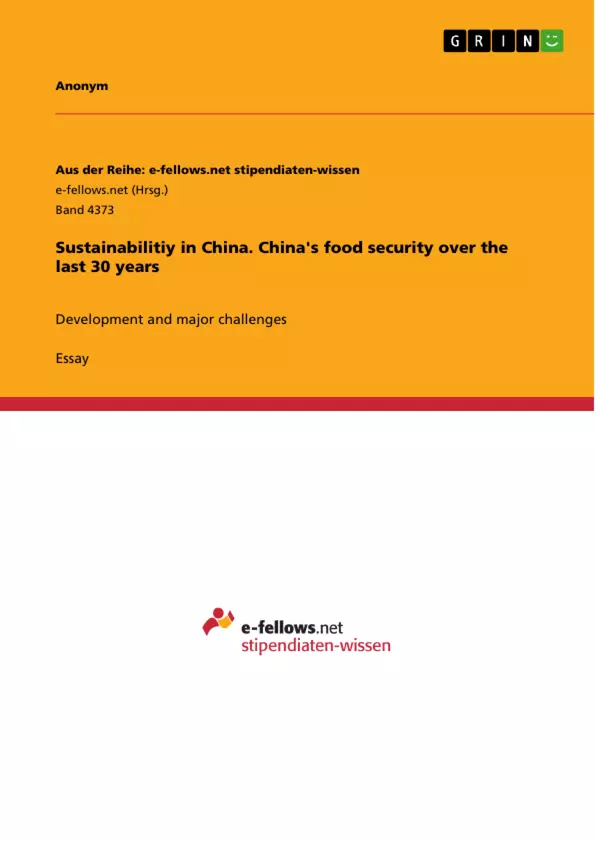A major strategic goal and task of governments around the globe is ensuring adequate nutrition for the country´s population and thus providing sufficient food security. On the supranational level, the Food and Agriculture Organization (FAO) has committed itself to this task and continuously works towards combating hunger and malnutrition worldwide. At the World Food Summit in Rome in 1996, the organization and 186 country leaders developed a framework and complex definition of food security that is still valid today: “Food security exists when all people, at all times, have physical and economic access to sufficient, safe and nutritious food that meets their dietary needs and food preferences for an active and healthy life” (World Food Summit 1996). This definition reflects the complexity and multidimensionality of the topic, as it includes a sufficient availability of qualitative valuable food, access to adequate nutritional resources, as well as stability and utilization. The latter emphasizes the inherent need for complementary resources like clean water and sanitary facilities, whereas the dimension of stability adds the indispensability of resilience and predictability of sufficient food resources to prevent losing access to food due to external shocks.
Likewise, food itself is also multidimensional. As it is needed continually and on a regular basis, timing and daily availability are central requirements. Additionally, food must be available at a reasonable price at the market and moreover fulfils socio-cultural functions. As each culture has its own diet traditions and norms, not everything edible is socially or culturally accepted. Constraints and preferences must therefore be considered when assessing a country´s food security. To evaluate the development of China´s food security over the last three decades, this paper analyzes the aspect of food availability by elaborating the development of the country´s meat and crop production, its import and export volumes as well as its population size and diet habits. Thereafter, major challenges for food security in China, such as an unsustainable use of resources, the impact of climate change and of urbanization, are illustrated. The discussion is then followed by an outlook on promising and viable solutions to maintain and further increase China's future food availability and thus meet the central requirement of national food security.
Inhaltsverzeichnis (Table of Contents)
- Introduction
- Development of Chinese food security over the last 30 years
- Meat and crop production
- Import and export volumes
- Population size and diet habits
- Major challenges
- Unsustainable use of resources
- Climate change
- Urbanization
- Viable solutions
- Yield increase
- Diet change
- Conclusion
Zielsetzung und Themenschwerpunkte (Objectives and Key Themes)
This paper examines the development of China's food security over the past three decades, focusing on the country's meat and crop production, import and export volumes, population size, and diet habits. It further investigates the major challenges facing China's food security, such as unsustainable resource use, climate change, and urbanization. Finally, the paper explores viable solutions to maintain and enhance future food availability and meet the demands of national food security.
- Food Security in China
- Development of Meat and Crop Production
- Import and Export Dynamics
- Population Growth and Dietary Shifts
- Challenges to Food Security
Zusammenfassung der Kapitel (Chapter Summaries)
- Introduction: This chapter provides a general overview of food security as a global strategic goal, emphasizing the complex multidimensionality of the concept, encompassing aspects like availability, accessibility, utilization, and stability. The importance of considering cultural factors in food consumption is also highlighted.
- Development of Chinese food security over the last 30 years: This chapter examines the significant increase in meat and crop production in China over the past three decades, highlighting the rise in meat consumption and the importance of grain security in the country. The chapter also analyzes China's import and export volumes of agricultural products, emphasizing the country's role as a major player in global food production and trade.
- Major challenges: This chapter focuses on the major challenges facing China's food security, including the unsustainable use of resources, the impact of climate change, and the effects of urbanization. These challenges are discussed in detail, highlighting their potential impact on future food availability and national food security.
- Viable solutions: This chapter explores promising and viable solutions to maintain and enhance China's future food availability, including measures such as increasing agricultural yields and promoting dietary change. The chapter discusses how these solutions can contribute to achieving national food security goals.
Schlüsselwörter (Keywords)
This paper focuses on key concepts such as food security, agricultural production, meat consumption, crop yields, grain security, import and export, urbanization, climate change, sustainable resource use, and dietary change, all within the context of China's evolving food landscape.
- Citation du texte
- Anonym (Auteur), 2022, Sustainabilitiy in China. China's food security over the last 30 years, Munich, GRIN Verlag, https://www.grin.com/document/1451459



